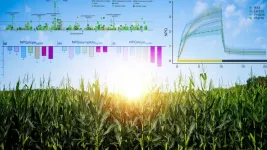(Press-News.org) Awash in a rowed sea of its brethren, a corn leaf relegated to the lowest rung of its stem spends much of a June afternoon doused in shade cast by the higher-ups.
Then a gust begins pushing, pulling and twisting the waxy wings in concert, cracking a window to the fireball roiling 93 million miles away. It’s a prime, precious opportunity for photosynthesis to transform the sunlight into food. Unfortunately, the photosynthetic equivalent of a surge protector — one evolved to help plants mitigate damage driven by sudden spikes of high-intensity light — is slow to reset after so much time in the shade. The gust dissipates, the moment gone before the leaf and its cellular kitchen can take advantage.
A summer’s worth of those minute but missed opportunities to harvest light can cost cornfields, and those who farm them, a sizable portion of the potential harvests they yield in the fall. By recently identifying and measuring the influence of new genes that regulate the surge protector, the University of Nebraska–Lincoln’s Kasia Glowacka and colleagues could help increase those yields by upward of 20%.
Which isn’t to downplay the importance of the safeguard, which goes by the name of non-photochemical quenching, or NPQ, and can transform light to heat whenever a plant absorbs more of the former than it can put toward photosynthesis. A failure to cut the biochemical circuit, after all, can lead to a toxic buildup of ultra-reactive oxygen that damages DNA and can even kill a cell. But the safety measure has a downside: The slower it is to relax and resume letting the absorbed light fuel photosynthesis, the more of that energy-granting light it wastes.
“When you think from the perspective of a chloroplast in a plant cell, life is really difficult,” said Glowacka, assistant professor of biochemistry at Nebraska. “Every few seconds, the environment is changing.”
In 2016, Glowacka contributed to a study showing that cranking up the activity of three particular genes allowed tobacco plants to switch NPQ on and off at a much faster pace, granting it both better protection and more efficient photosynthesis. That tobacco, in turn, produced leaves roughly 20% larger, with simulations suggesting that even greater gains might be possible. Follow-up research found that the same technique could generate similar benefits in soybean — not just for leaves, but the beans, too.
But tobacco and soybean employ a different form of photosynthesis than corn, sorghum, sugarcane and several other crops better suited to hot and dry conditions — crops whose yields must increase to help feed the 10 billion people expected to populate the globe by 2050. Glowacka wondered whether the genes that coded for NPQ activity in one might play that same role in the other. Even if they did, Glowacka and Nebraska’s James Schnable figured there must be other genes aiding a process as complex as NPQ.
They were right. Their discovery began with toiling in the fields during the summers of 2020 and 2021, when the team planted more than 700 genetically different lines of corn at the Havelock Research Farm in northeast Lincoln. Glowacka’s plan: look for differences in NPQ performance among the lines, then try to tease out which genes were ultimately responsible for those differences. Still, the existing methods for measuring NPQ, Glowacka knew, were expensive and time-consuming. More than that, they struggled to flatten out daily disparities in each line’s exposure to light, potentially spoiling the validity of any findings.
Rather than settle, Glowacka developed her own method. The team used a modified hole-punch to extract tiny samples from the leaves of every line in the field. Back in the lab, the researchers gave the tissue samples nearly a day to adapt to the dark, eventually measuring their fluorescence — a proxy for photosynthesis and NPQ — before and after exposing them to flashes of light. Instead of measuring one sample every 20 minutes, the team was able to handle 96 samples over that same span.
The researchers found that the speed and magnitude of NPQ responses varied widely among the lines, a fact that helped ease the search for any new genes potentially driving that variation in corn. A comparison of the lines’ genetic code, cross-referenced against the differences in NPQ performance, eventually revealed six promising gene candidates. Several of those candidates were already familiar to the team. Others were not — including one called PSI3, which introduced more of that variation than any other candidate.
After identifying counterparts of those six genes in Arabidopsis, a flowering plant commonly used to study plant biology, the team proceeded to order mutants: Arabidopsis seeds each lacking one of the six genes. In all six of the mutants, the surge protector was generally sluggish to respond under the lights but also slower to relax when the lights were turned out. The NPQ peaks were typically lower, too, and the troughs higher, suggesting that the plants both buffered less against surges and squandered more of the light available for photosynthesis.
The identification of those genes, combined with the amount of natural NPQ variation across lines of corn, could open the way to breeding plants far better at capitalizing on yield-boosting sunlight, the researchers said. In the best case, Schnable said, those efforts might come to bear fruit in as little as a half-dozen years.
If they do, the results could prove a boon for crop breeders now investigating every and all possibilities to preclude global food shortages in the coming decades.
“We can gain 22% of that yield from the crops, potentially, if we were to speed up the NPQ,” Glowacka said.
Given that the researchers kicked off the study early in 2020, their attempts to help stem an impending global crisis meant dealing with a contemporary one. Two of the team’s members, Seema Sahay and Marcin Grzybowski, had only recently arrived in the United States — recently enough that neither had yet gotten a driver’s license. Prior to COVID-19, the two would have hitched rides out to the Havelock Research Farm.
University protocols designed to slow the spread of the virus, though, temporarily put that option on hold. Undeterred, Sahay and Grzybowski regularly resorted to biking roughly seven miles out to the research farm — a 30-plus-minute trek amid the heat and humidity of a Nebraska summer.
“Seema and Marcin,” Glowacka said, “are the real heroes of this experiment.”
END
Refining surge protector in crops could boost yields
ID’ing new genes may elevate efficiency of photosynthesis, up corn yields by 20%
2023-06-05
ELSE PRESS RELEASES FROM THIS DATE:
Moving towards a more inclusive approach to medicine
2023-06-05
Moving towards a more inclusive approach to medicine
Release of pangenome representing wide diversity of individuals ushers in new understanding of human biology and disease
The first human genome, which has served as the reference until now, was released approximately 20 years ago. It was a landmark accomplishment that had a huge impact on biomedical research and changed the way scientists study human biology. But it was based on just a few individuals and did not capture the full genetic diversity of the human population.
An important step forward for both biology and biomedical research
“Since ...
SwRI investigates accuracy of flow meters measuring hydrogen and natural gas blends
2023-06-05
SAN ANTONIO — June 5, 2023 —Southwest Research Institute is expanding its flow meter research in collaboration with NYSEARCH, a nonprofit research and development organization for the gas industry, to address the impact of introducing hydrogen and natural gas blends into the residential and commercial energy mix. In the second phase of the program, SwRI will expand its research in measuring the energy content of blended gas to determine the accuracy of current flow meter technology for monitoring usage in homes.
Natural gas is widely used to power appliances and heat ...
Social media posts can be used to track individuals’ income and economic inequalities
2023-06-05
Researchers from Queen Mary University of London analysed 2.6 million posts on popular social media network Nextdoor and accurately predicted individuals’ income by solely examining the posts they’ve published. Striking differences in the content shared by people who live in wealthier versus poorer neighbourhoods has led researchers to believe that our general online posting activity, beyond Nextdoor, can reveal our socioeconomic status, making user profiling possible.
Knowing users’ income could allow social media platforms to recommend income-based content, and advertisers and online shops can target people based on their ...
ASCO: Targeted therapy achieves responses across multiple cancer types with FGFR alterations
2023-06-05
ABSTRACTS: 3121, 4504, LBA4619
CHICAGO ― Three clinical trials led by researchers at The University of Texas MD Anderson Cancer Center demonstrated positive results from the targeted therapy erdafitinib for patients with multiple tumor types harboring FGFR alterations. The data are being presented at the 2023 American Society of Clinical Oncology (ASCO) Annual Meeting.
Erdafitinib is an oral medication that blocks the activity of FGFR signaling proteins, which are important for a variety of normal cellular processes. However, FGFR genetic alterations can drive the development of many ...
Patchwork of mutations contributing to bipolar disorder
2023-06-05
Bipolar disorder (BD) is a major psychiatric condition that afflicts about 1% of people. Symptoms of BD include sudden onset of depressive mood with loss of interest which alternates with a manic state of hyperactivity. The suffering of the patients and societal cost of this disorder requires the use of continued therapeutic management. Current medications—although vital for patients with BD—are not perfect solutions, given their potential side-effects and treatment resistance. This necessitates ...
Zap Energy charts roadmap for measuring fusion gain
2023-06-05
In the race to develop fusion energy, each unique approach requires its own specialized techniques to determine net energy gain, an equation balancing energy in and out that’s known by the letter Q.
A new paper, published today in the journal Fusion Science and Technology, establishes the company’s method of measuring and calculating Q in Zap’s sheared-flow-stabilized Z-pinch fusion plasmas. The publication will be an important part of Zap demonstrating energy gain on the way to building a commercial fusion ...
Children with attention, behavior problems earn less money, have less education, poorer health as adults
2023-06-05
Children who struggle with attention and behavior problems tend to end up earning less money, finish fewer years of school and have poorer mental and physical health as adults, compared with children who don’t show early attention and behavior problems, according to research published by the American Psychological Association.
Children who struggle with attention are particularly likely to have lower levels of educational attainment as adults, while those who struggle with impulsivity are more likely to end up in trouble with the law, the research found.
“Our study found broad support ...
Previously unknown antibiotic resistance widespread among bacteria
2023-06-05
Genes that make bacteria resistant to antibiotics are much more widespread in our environment than was previously realised. A new study, from Chalmers University of Technology and the University of Gothenburg in Sweden, shows that bacteria in almost all environments carry resistance genes, with a risk of them spreading and aggravating the problem of bacterial infections that are untreatable with antibiotics.
“We have identified new resistance genes in places where they have remained undetected until now. These genes can constitute an overlooked threat to human health,” says Erik Kristiansson, a professor in the Department ...
New INSPIRE group data shows “long COVID” not a single condition
2023-06-05
The latest data from the nationwide INSPIRE study assessing the long-term symptoms and outcomes of the COVID-19 virus in nearly 6000 participants identifies four clinically distinct symptom presentations (phenotypes),adding to the growing body evidence that Long COVID is not singular condition but rather a range of conditions that may evolve, and typically improve, over time.
Lead author Michael Gottlieb, MD, says this better understanding of the clinically distinct manner that patients experience post-COVID -19 complications ...
Researchers find major link between cardiovascular health and disorders such as carpal tunnel syndrome, rotator cuff tendinitis
2023-06-05
People with higher risks of cardiovascular disease are significantly more likely to develop carpal tunnel syndrome, tennis elbow, golfer’s elbow, and rotator cuff tendinitis, according to a new study involving researchers at the University of Utah and the Rocky Mountain Center for Occupational and Environmental Health.
The findings of the study, published June 2 in the Journal of Occupational and Environmental Medicine, have implications for the prevention and treatment of these common musculoskeletal disorders, which affect ...
LAST 30 PRESS RELEASES:
Numbers in our sights affect how we perceive space
SIMJ announces global collaborative book project in commemoration of its 75th anniversary
Air pollution exposure and birth weight
Obstructive sleep apnea risk and mental health conditions among older adults
How talking slows eye movements behind the wheel
The Ceramic Society of Japan’s Oxoate Ceramics Research Association launches new international book project
Heart-brain connection: international study reveals the role of the vagus nerve in keeping the heart young
Researchers identify Rb1 as a predictive biomarker for a new therapeutic strategy in some breast cancers
Survey reveals ethical gaps slowing AI adoption in pediatric surgery
Stimulant ADHD medications work differently than thought
AI overestimates how smart people are, according to HSE economists
HSE researchers create genome-wide map of quadruplexes
Scientists boost cell "powerhouses" to burn more calories
Automatic label checking: The missing step in making reliable medical AI
Low daily alcohol intake linked to 50% heightened mouth cancer risk in India
American Meteorological Society announces Rick Spinrad as 2026 President-Elect
Biomass-based carbon capture spotlighted in newly released global climate webinar recording
Illuminating invisible nano pollutants: advanced bioimaging tracks the full journey of emerging nanoscale contaminants in living systems
How does age affect recovery from spinal cord injury?
Novel AI tool offers prognosis for patients with head and neck cancer
Fathers’ microplastic exposure tied to their children’s metabolic problems
Research validates laboratory model for studying high-grade serous ovarian cancer
SIR 2026 delivers transformative breakthroughs in minimally invasive medicine to improve patient care
Stem Cell Reports most downloaded papers of 2025 highlight the breadth and impact of stem cell research
Oxford-led study estimates NHS spends around 3% of its primary and secondary care budget on the health impacts of heat and cold in England
A researcher’s long quest leads to a smart composite breakthrough
Urban wild bees act as “microbial sensors” of city health.
New study finds where you live affects recovery after a hip fracture
Forecasting the impact of fully automated vehicle adoption on US road traffic injuries
Alcohol-related hospitalizations from 2016 to 2022
[Press-News.org] Refining surge protector in crops could boost yieldsID’ing new genes may elevate efficiency of photosynthesis, up corn yields by 20%








